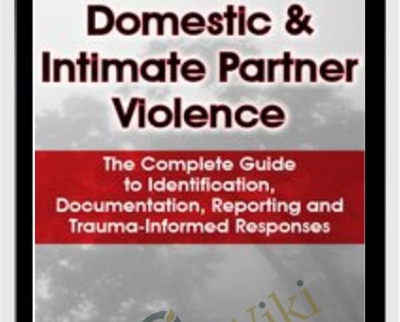$219.99 Original price was: $219.99.$83.00Current price is: $83.00.
All clinicians are likely to encounter Domestic and Intimate Partner Violence at some point in their practice. And if you fail to recognize the abuse and properly respond, the consequences can be dire.
 Purchase this course you will earn 83 Points worth of $8.30
Purchase this course you will earn 83 Points worth of $8.30Elevate your skills with the Domestic & Intimate Partner Violence: The Complete Guide to Identification, Documentation, Reporting and Trauma-Informed Responses course, available for just $219.99 Original price was: $219.99.$83.00Current price is: $83.00. on Utralist.com! Browse our curated selection of over 60,000 downloadable digital courses across diverse Uncategorized. Benefit from expert-led, self-paced instruction and save over 80%. Start learning smarter today!
All clinicians are likely to encounter Domestic and Intimate Partner Violence at some point in their practice. And if you fail to recognize the abuse and properly respond, the consequences can be dire.
But abuse can be difficult to detect when the physical signs of violence fade. And now more than ever, you’re conducting video sessions, giving you a unique glimpse into clients homes and potential abuse. It’s a complicated situation that can leave you caught between confidentiality, autonomy, and your wider responsibilities to protect victims.
What clinical decisions should you make to balance supporting your client while adhering to your licensure requirements?
Katelyn Baxter-Musser, LCSW has provided behavioral health counseling, crisis intervention and support to families and individuals facing domestic violence and abuse for over a decade.
Watch her in this one-day training that will serve as an indispensable guide for improving outcomes for those impacted by domestic and intimate partner violence. Not only will she answer your most pressing questions, you’ll walk away with:
- Screening tools to assess for safety, risk and lethality
- Checklists and advocacy resources
- Documentation and confidentiality strategies
- Guidance on crisis intervention and safety planning
- Culturally competent responses to abuse
- Trauma-informed interventions for clients exposed to domestic violence
- Tips for handling complex domestic violence situations created by COVID-19 and video sessions
Plus, Katelyn will share 3 powerful techniques to help you manage the burnout and compassion fatigue that can weigh you down when working with these emotionally draining cases!
Whether you’re a social worker, counselor, psychologist, marriage and family therapist, nurse, or anyone in the helping professions, this is one program you can’t afford to miss.
Purchase today!
- Employ screening techniques to identify the signs of domestic violence (DV) and intimate partner violence (IPV) in clients.
- Investigate how evidence-based screenings and assessments can help clinicians determine level of risk and lethality so they can intervene in crisis situations.
- Analyze ways in which clinicians can ensure proper reporting and documentation when working with clients facing violence in their relationships or homes.
- Evaluate the types of domestic abuse including physical violence, sexual violence, threats and intimidation.
- Justify how an understanding of cultural factors can help clinicians to ensure a competent response to abuse.
- Develop safety plans with clients to help them leave an abusive or violent home.
- Utilize trauma-informed treatment techniques for survivors of abuse, violence and oppression.
Get Domestic & Intimate Partner Violence: The Complete Guide to Identification, Documentation, Reporting and Trauma-Informed Responses – Katelyn Baxter-Musser, Only Price $87
Domestic and Intimate Partner Violence 101
- Myths about domestic and intimate partner violence
- Defining Abuse: Types of domestic violence
- Who is at risk?
- Warning signs and symptoms
- Substance abuse and domestic violence
- Abuse in the LGBTQ Community
- COVID-19 and impact on DV/IPV
Recognize the Red Flags of Violence: What All Clinicians Need to Know
- Screening and assessment techniques
- Identify immediate danger
- Tools to assess for safety, risk and lethality
- Checklists and advocacy resources
- Technology and domestic/intimate partner violence
Reporting Requirements and Documentation Guidelines
- Privacy and confidentiality
- Who is required to report and when?
- Standards for making a report
- Domestic violence hotlines
- Proper documentation and confidentiality strategies
The Next Steps: Crisis Intervention & Safety Planning
- Barriers to leaving
- Safety plans while living with abusive partners
- Safety planning for children
- Emotional safety planning
- Plans for leaving and after leaving
- Restraining orders/protective orders
Culturally Competent Responses to Abuse
- Recognizing your own biases
- How survivors interpret domestic violence in their culture
- Adapting danger assessments for underserved populations
- What is victim-blaming and how to avoid it
Trauma-Informed Interventions: Transition Clients from Surviving to Thriving
- Assess for PTSD, anxiety, trauma and other mental health issues
- Understand the multilayered impact of DV/IPV
- Processing shame, anger and guilt
- Working with children exposed to domestic violence
- Research, limitations and treatment risks
Vicarious Trauma & The Clinician
- What is compassion fatigue
- Recognizing signs of burnout
- Self-care techniques for the professional
Get Domestic & Intimate Partner Violence: The Complete Guide to Identification, Documentation, Reporting and Trauma-Informed Responses – Katelyn Baxter-Musser, Only Price $87
Tag: Domestic & Intimate Partner Violence: The Complete Guide to Identification, Documentation, Reporting and Trauma-Informed Responses Review. Domestic & Intimate Partner Violence: The Complete Guide to Identification, Documentation, Reporting and Trauma-Informed Responses download. Domestic & Intimate Partner Violence: The Complete Guide to Identification, Documentation, Reporting and Trauma-Informed Responses discount.
Cultivate continuous growth with the Domestic & Intimate Partner Violence: The Complete Guide to Identification, Documentation, Reporting and Trauma-Informed Responses course at Utralist.com! Unlock lifetime access to premium digital content, meticulously designed for both career advancement and personal enrichment.
- Lifetime Access: Enjoy limitless access to your purchased courses.
- Exceptional Value: Benefit from savings up to 80% on high-quality courses.
- Secure Transactions: Your payments are always safe and protected.
- Practical Application: Gain real-world skills applicable to your goals.
- Instant Accessibility: Begin your learning journey immediately after buying.
- Device Compatible: Access your courses seamlessly on any device.
Transform your potential with Utralist.com!
Related products
= 85 Points
Uncategorized
= 35 Points
= 125 Points
Uncategorized
= 35 Points
Uncategorized
= 85 Points
= 85 Points
Uncategorized
Managing Patient Emergencies: Critical Care Skills Every Nurse Must Know – Dr. Paul Langlois
= 85 Points
Uncategorized
Legal Risks in Nursing Documentation – Use Extreme Caution When Skimming the Facts – Rosale Lobo
= 40 Points





